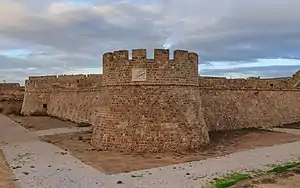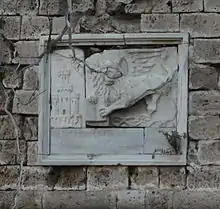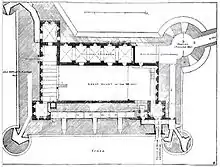Othello Castle
Othello Castle (Greek: Πύργος του Oθέλλου, Turkish: Othello Kalesi), also known as Othello's Tower, is a castle in Famagusta, Cyprus. It was built by the Lusignans in the 14th century, and was later modified by the Venetians. The modern name of the castle comes from a stage note in Shakespeare's play Othello.[1][2]
| Othello Castle | |
|---|---|
| Part of the Fortifications of Famagusta | |
| Famagusta, Northern Cyprus | |
 Othello Castle | |
| Coordinates | 35°7′39.7″N 33°56′35.7″E |
| Type | Castle |
| Site information | |
| Condition | Intact |
| Site history | |
| Built | 14th century late 15th century (modifications) |
| Built by | Kingdom of Cyprus Republic of Venice (modifications) |
| Materials | Sandstone |
History


Othello Castle was built in the 14th century by the Lusignans (who ruled the Kingdom of Cyprus) to protect the port against possible enemy attacks. It was also used as the main entrance to Famagusta. It used to be called "impenetrable fortress" due to it being nearly impossible to attack because of very deep ditches surrounding it.
After Cyprus was sold to the Republic of Venice, the castle's square towers were replaced with circular ones to suit more modern artillery. After these modifications, a relief of the Lion of St Mark was engraved above the castle's main entrance. The name of Captain Nicolo Foscari, who directed the alterations to the castle, and the date 1492 are inscribed near the relief. Apparently Leonardo da Vinci advised the refurbishment in 1481.[1] The castle gets its name from Shakespeare's famous play Othello, which is set in a harbour town in Cyprus.[3]
In 1900, the castle's ditch was drained of water to reduce the risk of malaria.[4]
The castle began to be restored in 2014,[5] and it reopened to the public on 3 July 2015.[6]
Layout
The castle contains four circular towers. It contains a refectory and a dormitory, which were constructed during the Lusignan period. The castle's yard contains cannonballs left behind by the Spaniards and Ottomans, relics of its turbulent history.[3]
Contemporary Literature
Currently, the only piece of contemporary prose literature that references and engages with Othello Castle in a first-person account is the creative nonfiction short story 'Green-eyed monster diary' by Dean Kerrison, set in the emerging (pre-pandemic) days of COVID-19, published in TEXT Journal of Writing and Writing Courses, April 2020.[7]
External References
References
| Wikimedia Commons has media related to Othello Castle. |
- Jessica Lee (February 2015). "Famagusta & the Karpas Peninsula". Cyprus (6th ed.). Singapore: Lonely Planet Publications Pty Ltd. p. 183. ISBN 978 1 74220 756 8.
The tower's name stems from a vague link [...] which has a modest stage note referring to 'a seaport in Cyprus'.
The note is in Othello, act 2, scene 1. - "North Cyprus Travel Guide | What to do in North Cyprus | Rough Guides". www.roughguides.com. Rough Guides. Retrieved 18 November 2020.
- "Othello's Tower and Citadel". cypnet.co.uk. Retrieved 3 October 2015.
- "Othello Tower and Castle". cyprus44.com. Retrieved 3 October 2015.
- Tsagari, Daphne (5 July 2014). ""Othello" Castle in Cyprus to be Restored". Greek Reporter. Retrieved 3 October 2015.
- "Othello Tower/Citadel to reopen this week". United Nations Development Programme. 29 June 2015. Retrieved 3 October 2015.
- Kerrison, Dean (April 2020). "Green-eyed monster diary" (PDF). TEXT Journal of Writing and Writing Courses. Vol 24, No 1.
Notes
